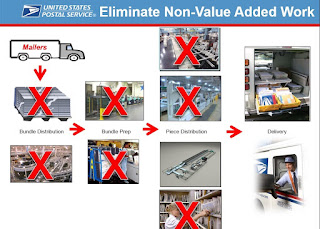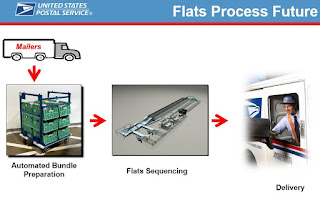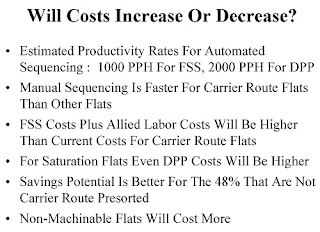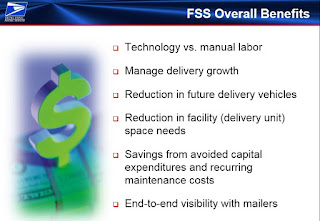 |
||||
| A 2011 presentation explained how FSS would streamline the handling of flat mail. Oops! |
What many have long suspected has now been confirmed: The U.S. Postal Service’s Flats Sequencing System is a disastrous failure that cannot be fixed.
The FSS is adding so much to the costs of handling magazines, catalogs, and other flat mail that no amount of machinery tweaks, Lean Six Sigma projects, or “Tiger Teams” can ever make it right.
“When all processing and delivery costs are included, an average Periodicals flat addressed to an FSS zone costs over 10.5 cents more than if addressed to a non-FSS zone,” postal expert Halstein Stralberg wrote recently. Assuming the same 40% cost differential applies as well to flat-shaped Standard Mail, such as catalogs and retailer flyers, Stralberg’s analysis indicates that FSS is adding several hundred million dollars annually to the Postal Service’s costs.
And that doesn’t even count the $1.3 billion spent on purchasing the huge machines or the additional investments in building modifications, training, and other start-up costs.
“Because of the large investment in the FSS and the great hopes that were attached to them, USPS managers appear still unwilling to admit that the program is a failure,” wrote Stralberg, a longtime consultant on postal costing and prices to Time Inc.
 |
| Another utopian vision from 2011 |
Based partly on Stralberg’s analysis, three mailer organizations recently called for the USPS to “(1) retire the FSS machines, (2) allow mailers of flat-shaped mail to prepare their mail for (and qualify for) Carrier Route and other discounts in all zones; and (3) make Carrier Route and other worksharing discounts for flats deep enough to cover 100 percent of the costs avoided by the worksharing.”
“These reforms alone should encourage enough co-mailing to enable Periodicals Mail and flat-shaped Marketing [aka Standard] Mail to cover all, or nearly all, of their attributable costs,” they told the Postal Regulatory Commission.
The three organizations are MPA-The Association of Magazine Media, the Association for Postal Commerce (aka PostCom), and the Alliance of Nonprofit Mailers.They submitted their comments and Stralberg’s analysis to the PRC to counter the USPS’s proposal to abolish the inflation-based cap on Periodicals postage rates, as explained in my recent Publishing Executive article, Postal Rate Fight Continues as Publishers Battle USPS “Stupidity Tax”.
 |
| A 2003 Stralberg presentation correctly predicted FSS mail would cost more than carrier-route flats. |
Stralberg’s predictions in 2003 about why FSS would not reduce flats-processing costs have turned out to have nearly prophetic accuracy, except the program turned out even worse than he expected.
For example, he contradicted postal officials who claimed that their costs for FSS-sorted pieces would be lower than for pieces in carrier-route bundles. (Postal officials now acknowledge that carrier-route mail is cheaper to deliver than FSS mail.)
But Stralberg never predicted that the FSS cost per Periodicals piece would be nearly double that of carrier-route pieces, as his recent analysis shows.
Here’s the MPA/PostCom/ANM summary of why the Postal Service’s assumptions about FSS turned out to be so fatally flawed:
1) “The Postal Service’s planners greatly underestimated the extent to which mailers would sort flats to the carrier route level.” About half of flat-mail copies were in efficient carrier-route bundles when FSS was first conceived more than a decade ago. Because of co-mailing and similar mail-consolidation efforts by printers, the proportion is now higher than 70% in non-FSS zones. (When a system nearly doubles the cost of handling 70% of the mail, it cannot possibly save enough on the other 30% to reach breakeven.)
 |
| The view from 2010, before reality intruded. |
2) “The Postal Service overstated the costs of manual sequencing of carrier route flats by carriers, and thereby overestimated the costs saved by diverting the sequencing work to the FSS.” Stralberg called out this flawed assumption in a 2003 presentation to mailers and postal officials.
3) “The Postal Service, erroneously assuming that practically all flats within an FSS zone would be placed in delivery sequence by the FSS, removed the vertical flats cases carriers had used for manual sequencing.” This triumph of optimism over reality adds to the amount of time carriers need to prepare flat mail for delivery. Barely half of the flats in FSS ZIP codes are presented to carriers in delivery sequence.
4) “The Postal Service’s planners incorrectly assumed that nearly all flats would be machinable on the FSS.” Stralberg warned in 2003 that flat mail unsuited for the Postal Service’s existing machines probably couldn’t be handled on the FSS, meaning that “non-machinable flats will cost more” under FSS.
 5) “The Postal Service’s predictions that practical concerns about the FSS machines themselves, including their footprint, cost, and complexity, would be solved during the design and implementation of the system proved incorrect.” That’s nearly a direct quote from Michael Plunkett, a USPS pricing manager when FSS was being developed and now PostCom’s President and CEO. He also told the PRC, “From the outset of the FSS project there was significant skepticism that the proposed technology would achieve the intended results and concern that substantial capital was being invested in a system that would unnecessarily complicate a network that already needed to be rationalized.”
5) “The Postal Service’s predictions that practical concerns about the FSS machines themselves, including their footprint, cost, and complexity, would be solved during the design and implementation of the system proved incorrect.” That’s nearly a direct quote from Michael Plunkett, a USPS pricing manager when FSS was being developed and now PostCom’s President and CEO. He also told the PRC, “From the outset of the FSS project there was significant skepticism that the proposed technology would achieve the intended results and concern that substantial capital was being invested in a system that would unnecessarily complicate a network that already needed to be rationalized.”
6) “Finally, because flats mail volume was lower than the Postal Service had expected, it added many outlying zones to the territory covered by each FSS machine, causing substantial service degradation.” Mailers warned postal officials more than a decade ago that digital disruption was reducing the volume of printed catalogs and magazines, but the Postal Service persisted with an FSS plan that assumed gradually increasing volumes. Flat mail peaked in 2005 and has dropped about 40% since then.